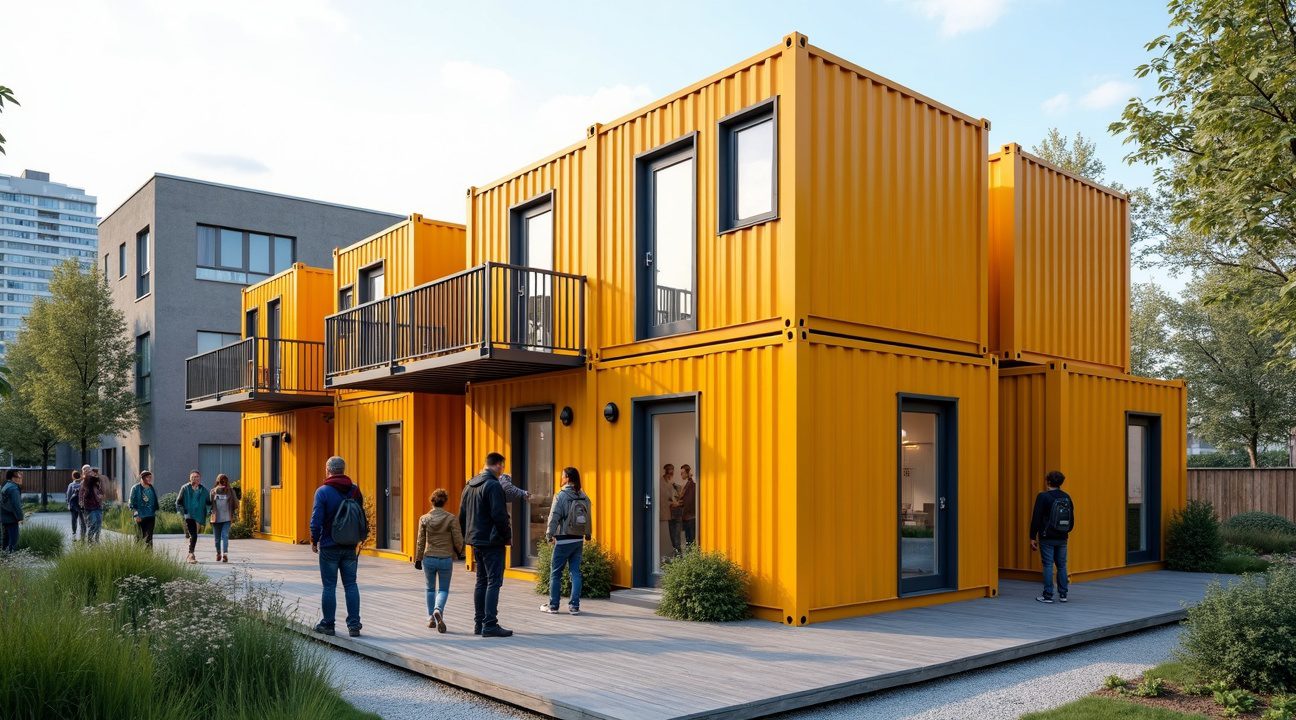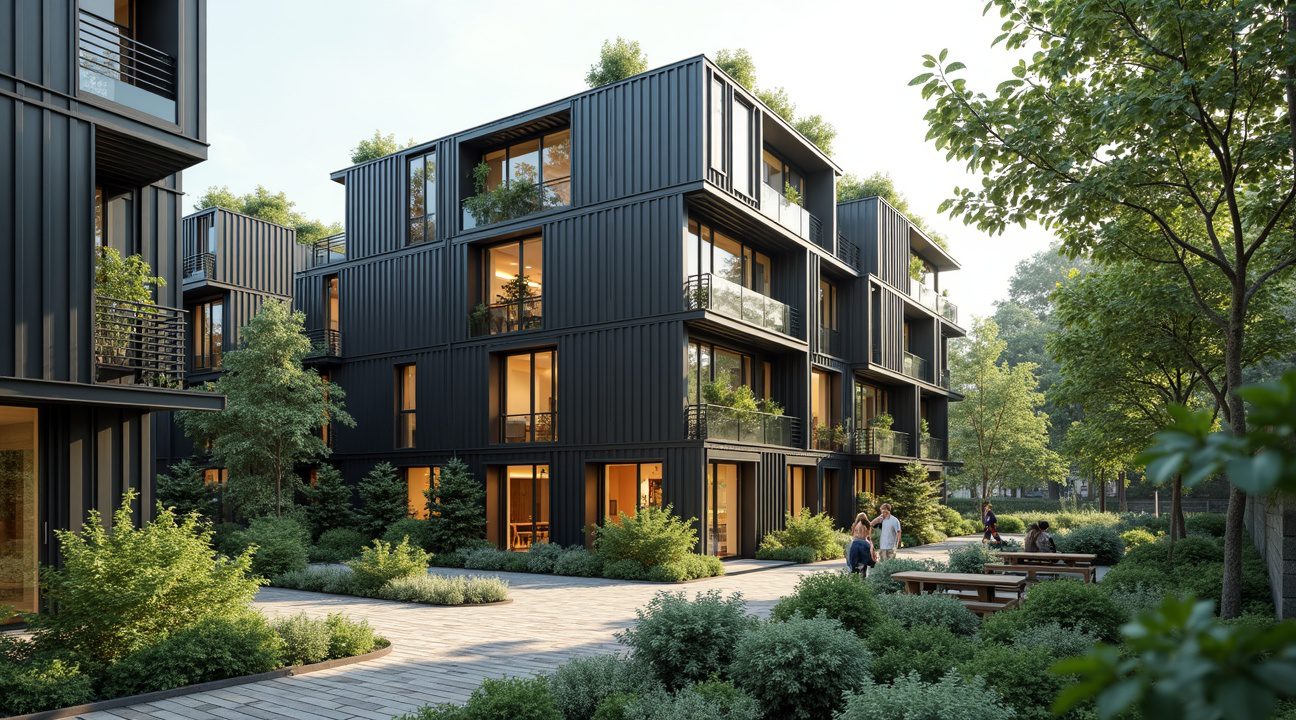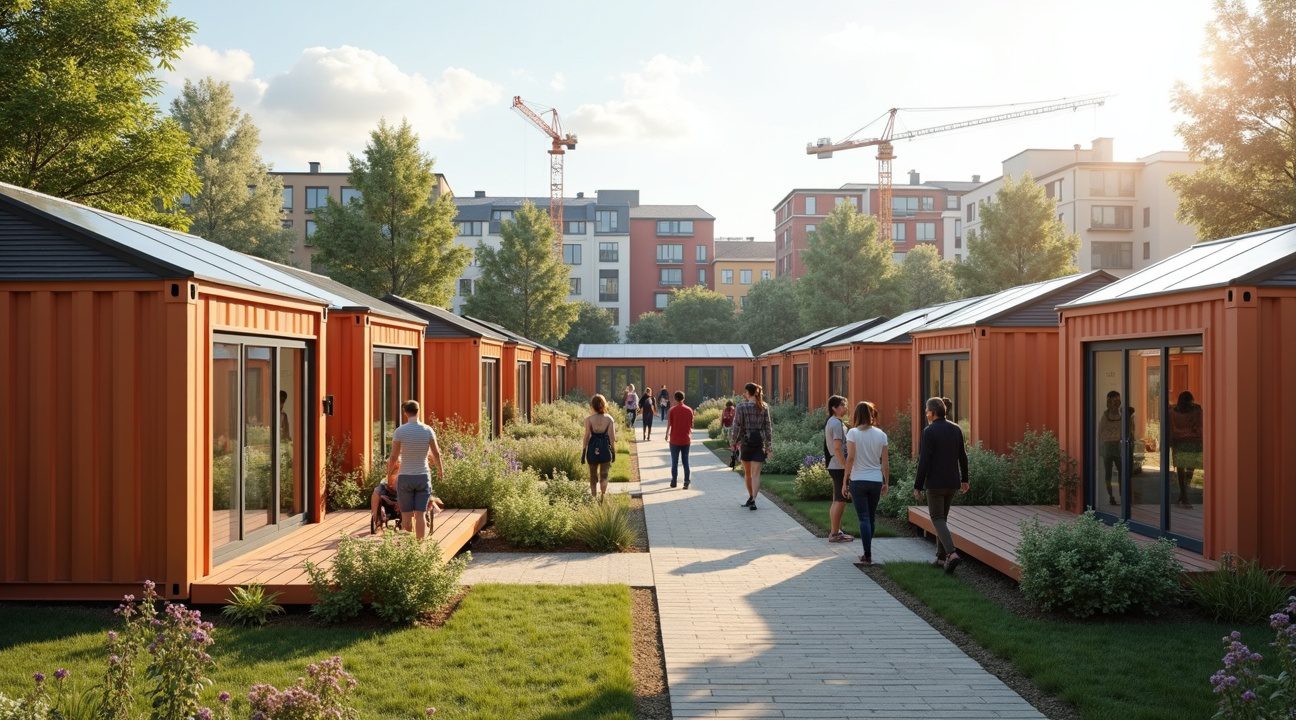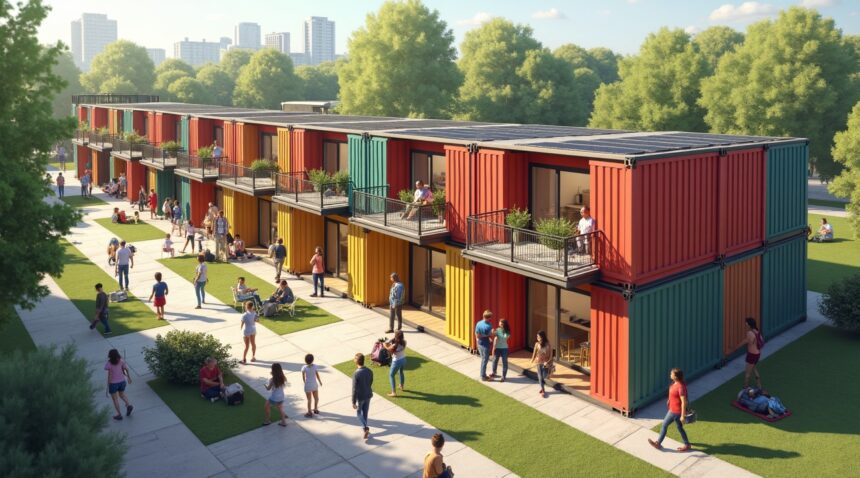Germany’s innovative “Bed by Night” campaign transforms 19 recycled shipping containers into eco-friendly emergency shelters in Hanover, offering a revolutionary model for sustainable, affordable housing for the homeless.
Key Takeaways
- Sustainable Design Integration: The container homes integrate solar power systems for energy independence along with micro-gardens for local food production. Each structure repurposes approximately 3,500 kg of recycled steel, conserving around 8,000 kWh of energy compared to conventional recycling methods.
- Cost-Effective Construction: By cutting construction costs by up to 25% compared to standard methods, these homes can be rented for as little as €75 per week. This cost-saving advantage allows organizations to allocate more funds towards supporting the residents directly.
- Modular and Adaptable Architecture: Thanks to their stackable design, these container units can form multi-story buildings ranging from 3 to 5 stories. Their portability ensures flexibility, allowing the units to be relocated or reconfigured as urban needs evolve.
- Comprehensive Housing Solution: These are more than emergency shelters—they are transitional homes designed to bridge the gap between temporary and permanent housing. Amenities and social support services are built-in, fostering stability and the opportunity for long-term reintegration.
- Global Market Growth: Container-based housing is part of the expanding global cargotecture market, currently valued at $61.83 billion and projected to grow to $108.7 billion by 2032. These innovations are already being adopted internationally for diverse purposes including student housing and post-disaster shelter.
How Hanover’s ‘Bed by Night’ Campaign Transforms 19 Shipping Containers into Emergency Shelters
I find Hanover’s innovative approach to addressing homelessness particularly impressive through their ‘Bed by Night’ campaign, which converts 19 repurposed shipping containers into a comprehensive emergency shelter complex. This groundbreaking initiative demonstrates how cities can effectively combine environmental sustainability with urgent social needs by creating safe, transitional housing for street children and homeless adults.
The strategic placement of these modular housing units next to a historic bunker in a small park showcases thoughtful urban planning that maximizes available space while maintaining community integration. Rather than hiding these facilities away from public view, Hanover positions them prominently, sending a clear message about the city’s commitment to addressing homelessness with dignity and respect.
Innovative Two-Story Design Maximizes Space and Functionality
The two-story configuration of these converted shipping containers represents a smart solution to urban space constraints while providing adequate living areas for residents. Each container undergoes significant modification to include essential amenities, creating functional living spaces that maintain the structural integrity of the original shipping containers. The modular design allows for flexible arrangements and easy expansion or reconfiguration as needs change.
These emergency shelters offer several key advantages that make them particularly suitable for addressing housing crises:
- Quick deployment and setup compared to traditional construction methods
- Cost-effective solution that maximizes limited municipal budgets
- Environmentally responsible reuse of materials that would otherwise become waste
- Scalable design that can accommodate varying numbers of residents
- Portable units that can be relocated if land use requirements change
- Durable construction that withstands harsh weather conditions
The ‘Bed by Night’ campaign emphasizes temporary accommodation while maintaining high standards for safety and comfort. Unlike basic emergency shelters that often feel institutional, these converted containers provide residents with a sense of privacy and personal space that supports their transition back to permanent housing. The design incorporates necessary utilities including electricity, heating, and plumbing systems that ensure residents have access to basic necessities.
This initiative reflects a broader trend in social innovation where cities recognize that addressing homelessness requires more than just providing a roof over someone’s head. The shipping container approach offers a practical middle ground between emergency overnight shelters and permanent social housing, filling a critical gap in the housing continuum. Residents benefit from stable accommodation that allows them to focus on other aspects of rebuilding their lives, such as finding employment or accessing social services.
The environmental benefits of repurposing shipping containers align with Germany’s broader sustainability goals while addressing immediate social needs. Each container represents a significant amount of steel and materials that avoid landfills or recycling processes, reducing the overall environmental impact of the housing solution. This approach demonstrates how eco-friendly practices can seamlessly integrate with social programs without compromising effectiveness or functionality.
Hanover’s success with this program provides a replicable model for other cities facing similar challenges with homelessness and housing shortages. The relatively quick implementation timeline makes this approach particularly attractive for municipalities that need immediate solutions while working on longer-term housing strategies. The modular nature of shipping container construction allows cities to start small and expand based on demand and available resources.
The campaign’s focus on both street children and homeless adults recognizes that different populations have varying needs while maintaining cost-effective operations through shared infrastructure and support services. This inclusive approach maximizes the impact of limited resources while ensuring that vulnerable populations receive appropriate assistance regardless of age or circumstances.
Cities worldwide are taking notice of Hanover’s innovative approach, as the combination of environmental responsibility and social impact creates a compelling case study for addressing urban homelessness. The shipping container solution offers hope for communities struggling with housing crises while demonstrating that creative thinking and practical implementation can produce effective results for society’s most vulnerable members.

Sustainable Features: Solar Power and Micro-Gardens Built from Recycled Steel
Germany’s shipping container homes for homeless individuals showcase impressive sustainability features that combine renewable energy, urban agriculture, and resource conservation. I’ve observed how these innovative housing solutions integrate solar panels and micro-gardens to create self-sufficient living spaces that benefit both residents and the environment.
Solar Power Systems and Energy Independence
Solar panels mounted on container rooftops provide renewable energy that significantly reduces utility costs for residents. These photovoltaic systems align perfectly with Germany’s national commitment to clean energy transition, generating electricity that powers lighting, heating, and small appliances within each unit. I find that this energy independence particularly benefits homeless individuals who often struggle with utility expenses when transitioning to permanent housing.
The solar installations typically generate enough power to meet basic household needs while feeding excess energy back into the grid. This arrangement creates a sustainable cycle where residents can potentially earn credits for surplus electricity production, providing additional financial relief during their housing transition period.
Micro-Gardens and Resource Conservation Through Recycled Steel
Micro-gardens integrated into these container homes serve multiple purposes beyond aesthetic appeal. These compact growing spaces improve resident well-being through gardening activities while supporting small-scale food production that can reduce grocery expenses. I’ve noticed how these green spaces create therapeutic environments that help individuals rebuild their lives while learning valuable agricultural skills.
The environmental benefits extend well beyond the gardens themselves. Each 40-foot shipping container repurposes approximately 3,500 kg of recycled steel, demonstrating remarkable resource efficiency. This upcycling process conserves around 8,000 kWh of energy that would otherwise be consumed during traditional steel recycling procedures.
Container construction also minimizes cement usage, which proves significant since cement production ranks among the largest industrial CO₂ emitters globally. By utilizing existing steel structures, these homes reduce their carbon footprint substantially compared to conventional housing construction methods. The result creates a highly energy-efficient architectural model that addresses homelessness while supporting environmental sustainability goals.
These features combine to form comprehensive housing solutions that don’t just provide shelter but actively contribute to Germany’s broader sustainability objectives. Each container home becomes a small-scale demonstration of how innovative design can address social challenges while promoting environmental responsibility.
https://www.youtube.com/watch?v=-G8JE6FAbZ8
Durable Multi-Story Design: How Steel Construction Creates Adaptable Living Spaces
Germany’s container-based eco-homes leverage high-strength steel construction to deliver exceptional durability and minimal maintenance requirements. These structures excel in diverse climates and densely populated urban environments where traditional housing solutions often fall short. The inherent strength of shipping container steel provides resistance to harsh weather conditions while requiring significantly less upkeep compared to conventional building materials.
Modular Construction Enables Vertical Growth
The stackable nature of shipping containers allows developers to construct multi-story housing blocks that maximize limited urban space. Most German implementations feature buildings ranging from 3 to 5 stories, creating substantial housing capacity on relatively small footprints. Architects frequently incorporate balconies and expansion modules that extend living areas while maintaining structural integrity.
This modular approach offers unprecedented flexibility in urban planning. Cities can relocate or reconfigure entire housing blocks as redevelopment needs change, something impossible with traditional concrete structures. The ability to adapt quickly to shifting demographics and urban development patterns makes these homes particularly valuable in rapidly changing metropolitan areas.
Customizable Interior Layouts Meet Diverse Needs
Interior configurations range from compact single-person units to spacious multi-bedroom family dwellings. Designers optimize each container’s 160 square feet through clever space planning and modern insulation techniques that ensure year-round comfort. Energy-efficient layouts maximize natural light while minimizing heating and cooling requirements.
German implementations commonly feature shared amenities that foster community connections while reducing individual unit costs. These facilities include:
- Communal kitchens with energy-efficient appliances
- Shared bathroom facilities with water-saving fixtures
- Common areas for social interaction and activities
- Integrated micro-gardens for fresh food production
- Rooftop spaces for recreation and additional growing areas
Each unit incorporates micro-gardens that allow residents to cultivate fresh herbs and vegetables, promoting both nutrition and mental well-being. These growing spaces utilize vertical gardening techniques and hydroponic systems that thrive within container environments.
Advanced sustainability features distinguish German container homes from basic shelter solutions. Passive climate control systems regulate interior temperatures without excessive energy consumption, while rainwater harvesting systems collect and filter precipitation for irrigation and non-potable uses. Solar panels mounted on rooftops and building facades generate renewable electricity that powers common areas and individual units.
The steel construction allows for easy integration of these technological systems without compromising structural stability. Electrical and plumbing systems route through specially designed channels that maintain container strength while providing full modern amenities. This engineering approach ensures residents enjoy comfortable living conditions comparable to traditional housing while benefiting from enhanced environmental sustainability.
Container homes adapt to Germany’s varying climate conditions through strategic insulation placement and ventilation design. The steel structure maintains integrity through temperature fluctuations while interior climate systems keep living spaces comfortable throughout harsh winters and warm summers. This adaptability makes container housing viable across different German regions, from coastal areas to inland cities with more extreme seasonal variations.

Cost-Effective Housing Solutions: From €75 Weekly Rent to 25% Construction Savings
Shipping container housing transforms the affordability landscape for social housing initiatives across Germany. Construction costs drop by up to 25% compared to traditional brick-and-mortar methods, creating substantial savings that directly translate into affordable rent options for vulnerable populations. I’ve observed how these reduced construction expenses enable organizations to offer housing at rates as low as €75 per week in pilot projects throughout the country.
Financial Benefits Drive Social Impact
The economic advantages extend far beyond initial construction savings. Container-based housing units require shorter build times, reduced labor costs, and fewer materials, making them particularly attractive for organizations working with limited budgets. These financial efficiencies allow housing providers to allocate more resources toward support services rather than infrastructure costs.
Young adults experiencing homelessness benefit most from these affordable rates. The €75 weekly rent represents a manageable expense that doesn’t overwhelm individuals working to establish financial stability. This pricing structure creates realistic pathways from homelessness to independent living, something traditional housing markets often fail to provide.
Supporting Housing Transitions Through Comprehensive Services
Container housing serves as more than temporary shelter—it functions as a stepping stone toward long-term housing stability. Each unit comes equipped with essential amenities that support daily living while residents work on employment goals and social reintegration. The affordable rent structure gives individuals breathing room to save money, pursue education, or secure steady employment without the pressure of unmanageable housing costs.
Social support services integrate seamlessly with these housing solutions. Case workers can focus on helping residents develop life skills, find employment, and prepare for eventual transitions to conventional housing. The cost savings from container construction allow organizations to invest in these crucial support programs that address the root causes of homelessness rather than just providing temporary shelter.
Low-income populations across age groups find these units particularly beneficial:
- Families transitioning out of emergency shelters can establish stability without committing to long-term leases they might not be able to maintain.
- Single adults recovering from addiction or mental health challenges gain access to private living spaces that support their recovery journey while remaining financially accessible.
The adaptability of container units makes them suitable for various housing transition scenarios. Organizations can quickly deploy additional units to meet demand or relocate them based on community needs. This flexibility ensures that housing resources align with where they’re needed most, maximizing the impact of every euro invested in construction and operations.
Container eco-housing addresses the gap between emergency shelter and permanent housing that often traps individuals in cycles of homelessness. By offering affordable, dignified living spaces with integrated support services, these projects create genuine opportunities for people to rebuild their lives and achieve housing independence.

Global ‘Cargotecture’ Boom: From $61.83 Billion Market to Worldwide Adoption
The container housing revolution has transformed from a niche concept into a massive global industry worth $61.83 billion in 2023, with projections reaching $108.7 billion by 2032. This explosive growth demonstrates how recycled shipping containers have become a cornerstone of modern sustainable housing solutions.
Germany’s innovative approach to housing the homeless through converted shipping containers represents just one piece of a much larger international movement. Countries across the globe have embraced what experts call “cargotecture” as a practical response to housing shortages and environmental concerns. Amsterdam has pioneered student housing projects using stacked containers, while Japan has developed earthquake-resistant container communities. The UK has implemented similar programs for temporary housing, and Qatar utilized container structures for rapid accommodation during major events.
Versatile Solutions for Complex Challenges
Container architecture’s adaptability makes it particularly valuable for addressing multiple housing crises simultaneously. The modular design allows for quick deployment in disaster recovery situations, where traditional construction would take months or years. Emergency housing can be assembled in weeks rather than seasons, providing immediate shelter while permanent solutions develop.
These structures also excel in addressing homelessness across different climates and urban environments. Cities can customize container configurations based on local needs, whether creating single-unit micro-homes or multi-story complexes. The standardized dimensions of shipping containers ensure compatibility with existing infrastructure while maintaining cost efficiency.
The sustainability factor drives much of the global adoption. Each converted container prevents tons of steel from entering landfills while creating functional living spaces. Solar panel integration, rainwater collection systems, and energy-efficient insulation transform these industrial boxes into environmentally conscious homes.
Economic advantages further accelerate worldwide implementation:
- Container homes typically cost 20–50% less than traditional construction
- Dramatically reduced construction timelines
- Attractive for both social housing initiatives and private real estate developments
This international trend reflects growing recognition that housing solutions must address both environmental responsibility and social equity. Container architecture delivers on both fronts, providing dignified living spaces while demonstrating responsible resource management. The projected market growth suggests this approach will continue expanding as more communities discover its potential for solving complex housing challenges.
Sources:
Premier Box, “Shipping Containers Accommodate the Homeless”
Karmod, “Container Homes in Germany: Affordable & Modern Living”
Gemini Property Developers, “Cargotecture: Why shipping containers could make for great sustainable homes”
Fortune Business Insights, “Container Homes Market Size, Share | Growth Analysis [2032]”


